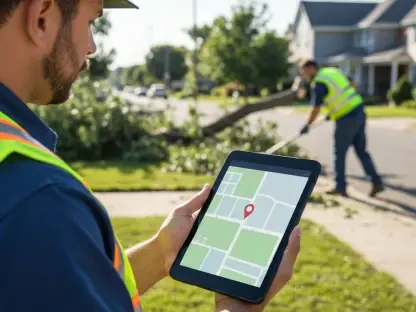Aircraft maintenance, repair, and overhaul (MRO) operations are on the brink of a revolutionary transformation, thanks to the integration of augmented reality (AR) technologies. Modern AR solutions like PartWorks’ RepĀR™ are set to redefine industry standards by optimizing precision, efficiency, and reliability. This article delves into the multifaceted impact of AR on MRO workflows and explores the collaborative efforts behind these innovations.
The Rise of Augmented Reality in MRO
Embracing Innovation
Augmented reality has emerged as a game-changing technology in various sectors, with the aviation industry being no exception. By superimposing digital information onto the physical world, AR provides unparalleled accuracy and real-time insights essential for effective MRO processes. This innovative approach allows technicians to overlay complex schematics and repair instructions directly onto the aircraft, eliminating the need for traditional printed manuals and minimizing the risk of misinterpretation. The convenience of working hands-free and the ability to access critical information on demand significantly streamline MRO operations, enhancing both efficiency and safety.
One of the primary advantages of AR technology in MRO is its ability to present information contextually, right when and where it is needed. For instance, AR can alert technicians to specific areas requiring attention, display step-by-step repair instructions, and even suggest optimal tool usage based on the task at hand. This seamless integration between digital guidance and physical work ensures that maintenance activities are performed accurately and consistently. The use of AR in this manner not only accelerates repair times but also ensures that all repairs meet stringent industry standards, thereby improving the overall reliability of aircraft maintenance.
Enhancing Precision and Accuracy
One of the most significant advantages of AR in MRO is its ability to enhance precision. AR overlays guide technicians by accurately identifying fastener locations and validating tool placements, thereby reducing the likelihood of human errors and ensuring that repairs are conducted correctly the first time. The technology employs advanced image recognition algorithms and spatial awareness to detect and highlight components, providing technicians with a clear visual representation of the necessary repairs. This capability is particularly useful for addressing complex structural issues that require pinpoint accuracy and meticulous attention to detail.
Furthermore, the real-time validation features of AR systems allow technicians to verify each step of the maintenance process instantaneously. As a technician completes a task, the AR system can confirm the correct execution of the procedure, flagging any discrepancies or mistakes for immediate correction. This reduces the need for extensive post-repair inspections and minimizes the chances of rework. By facilitating precise and error-free maintenance activities, AR contributes to prolonged aircraft longevity and reliable performance, ultimately improving operational uptime and reducing costs associated with unscheduled repairs.
Efficiency and Cost-Effectiveness
Accelerating Workflows
AR solutions streamline maintenance workflows, leading to a considerable reduction in aircraft downtime. The real-time validation and instruction capabilities of AR enable technicians to perform tasks more quickly and accurately, significantly accelerating return-to-service timelines. For instance, the ability to access digital repair manuals directly through AR glasses means that technicians spend less time searching for relevant information, allowing them to focus on executing repairs efficiently. Moreover, automated guidance can direct technicians through the optimal sequence of tasks, minimizing unnecessary movement and ensuring that each step contributes towards the timely completion of maintenance procedures.
Enhanced efficiency through AR is not limited to individual tasks but extends to broader workflow optimization. Maintenance teams can synchronize their efforts using shared AR systems, allowing for real-time collaboration and information sharing. This ensures that all team members are aligned and working towards common goals, reducing the likelihood of bottlenecks and miscommunication. Additionally, AR-based training modules can help quickly onboard new technicians, allowing them to rapidly gain the expertise needed to contribute productively to MRO operations. Collectively, these advancements foster a more agile and responsive maintenance environment, capable of meeting the evolving demands of the aviation sector.
Reducing Labor Costs
By integrating spatial awareness and real-time validation into maintenance procedures, AR reduces the need for highly skilled labor for routine tasks. This not only lowers labor costs but also allows experienced technicians to focus on more complex tasks, further improving overall efficiency. AR’s ability to provide step-by-step guidance and error-checking means that less experienced technicians can perform standard maintenance activities with greater confidence and accuracy. Consequently, employers can allocate resources more effectively, utilizing less experienced staff for routine work and reserving seasoned technicians for tasks that require deeper technical expertise and problem-solving skills.
Labor optimization through AR is further supported by data analytics and performance tracking. AR systems can monitor and record technician activities, providing valuable insights into productivity, task completion times, and areas for improvement. This data enables better workforce management, identifying opportunities to streamline processes and reduce inefficiencies. Additionally, predictive maintenance capabilities can signal when specific components or systems are likely to require attention, allowing for proactive scheduling and resource allocation. The combination of these factors leads to a more cost-effective MRO operation, capable of delivering high-quality maintenance services at lower operational expenses.
Technological Synergy
Integrating Advanced Technologies
The combination of AR with other advanced technologies such as computer vision and machine learning marks a transformative leap in aircraft MRO. These integrations ensure that even novice technicians can achieve results that match or exceed their experience levels, resulting in measurable productivity gains and improved maintenance outcomes. Computer vision enhances AR’s ability to recognize components and structures, providing accurate guidance and validation during the repair process. Machine learning algorithms, meanwhile, can analyze vast amounts of maintenance data to identify patterns and suggest optimal repair strategies, further enhancing the effectiveness of AR-guided procedures.
Technological synergy not only improves individual task execution but also elevates overall maintenance strategies. Data collected from AR interactions can feed into machine learning models, refining predictive maintenance capabilities and enabling more accurate failure forecasts. This allows maintenance teams to address potential issues before they escalate, thereby reducing unscheduled downtime and extending aircraft service life. Moreover, the integration of these technologies fosters continuous improvement, as iterative learning processes refine both AR systems’ accuracy and the overall efficiency of MRO operations. The result is a dynamic and adaptive maintenance environment, constantly evolving to meet the challenges of modern aviation.
Real-Time Validation
The synergy between machine learning and AR allows for immediate feedback and validation of maintenance tasks. This ensures that errors are caught and corrected instantaneously, thus reducing the need for rework and enhancing the reliability of the maintenance process. Real-time validation involves using AR systems to constantly monitor and verify each step of a task, comparing actual execution against pre-defined standards and guidelines. Should any deviations or inaccuracies be detected, the system can alert the technician immediately, providing corrective instructions or highlighting the mistake.
This proactive approach to error management is particularly valuable in complex and high-stakes MRO scenarios. Given the critical nature of aircraft safety, ensuring that all repairs conform to the highest standards is paramount. By leveraging real-time validation, maintenance teams can confidently perform their duties, knowing that their actions are continually assessed and validated. This not only minimizes the likelihood of costly errors but also enhances overall trust in the maintenance process. Furthermore, immediate feedback mechanisms help accelerate repair times, as technicians can address issues promptly without waiting for external inspections or reviews.
Collaborative Innovation
Research and Development
The development of advanced AR solutions like RepĀR™ is the result of collaborative efforts between industry leaders and academic institutions. For instance, the partnership between PartWorks and Georgia Tech highlights how combining practical industry insights with cutting-edge research can yield groundbreaking innovations. This collaboration began with a shared vision to leverage Extended Reality (XR) technologies to tackle real-world MRO challenges and has since produced tangible advancements in AR’s application within the aviation sector. The synergy between academic research and industry expertise ensures that AR solutions are not only technologically sound but also practically viable.
Collaboration in research and development fosters a multidisciplinary approach, combining various perspectives and skill sets to address complex problems. Researchers contribute deep theoretical knowledge and innovative thinking, while industry professionals offer practical insights and hands-on experience. This blend of academic rigor and field expertise leads to the creation of AR systems that are both sophisticated and user-friendly, capable of addressing the nuanced demands of aircraft maintenance. Additionally, such partnerships often involve iterative testing and refinement, ensuring that AR solutions are continually improved based on real-world feedback and evolving technological capabilities.
Case Studies and Real-World Applications
Real-world applications and case studies demonstrate the tangible benefits of AR in aircraft MRO. These examples showcase how collaborative innovation translates into practical solutions that enhance maintenance workflows, reduce costs, and improve overall safety. Case studies often provide detailed accounts of how AR technologies are deployed in actual maintenance scenarios, illustrating their impact on efficiency and precision. For instance, a case study might highlight how AR-guided repairs reduced turnaround times for a commercial airline, showcasing the direct correlation between AR implementation and operational productivity.
Real-world applications also underscore the adaptability and scalability of AR solutions. Whether utilized in small regional carriers or large international fleets, AR proves its versatility in various maintenance environments. Success stories from different sectors of aviation reveal common themes of improved accuracy, reduced errors, and cost savings. Additionally, case studies often highlight the user experience, demonstrating how technicians interact with AR systems and benefit from real-time guidance and validation. These practical insights reinforce the value of AR as an indispensable tool in modern MRO operations, capable of meeting diverse needs across the aviation industry.
Future Implications for the Aerospace Sector
Broadening AR Adoption
The successful implementation of AR in aircraft MRO sets a precedent for other industries to follow suit. As AR technologies continue to evolve, their adoption is expected to expand, bringing similar benefits to various sectors that require high precision and efficiency. Industries such as automotive manufacturing, healthcare, and construction are already exploring AR’s potential to enhance their operational workflows. The adaptability of AR to different contexts and its ability to provide precise guidance and real-time validation make it a valuable asset across a broad spectrum of applications.
Broader adoption of AR also drives further innovation, as ongoing research and development efforts seek to enhance its functionalities and user experience. Cross-industry collaboration can lead to the development of more robust and versatile AR systems, capable of addressing unique challenges in various fields. Additionally, widespread adoption creates economies of scale, reducing costs and making AR technologies more accessible to smaller enterprises. The cumulative effect of these advancements accelerates the integration of AR into mainstream operations, establishing it as a standard tool for achieving efficiency and precision in complex tasks.
Shaping Industry Standards
The aviation industry’s adoption of AR is likely to influence future MRO standards and practices. As more organizations experience the advantages of AR, the technology will become integral to the industry’s operations, shaping new norms and expectations for maintenance procedures. Regulatory bodies and industry associations may develop specific guidelines and best practices for AR implementation, ensuring that its use aligns with safety and operational standards. This formalization of AR within industry frameworks not only validates its effectiveness but also encourages wider acceptance and utilization.
The shift towards AR-driven MRO may also prompt changes in workforce training and development. Technicians will need to acquire new skills to effectively use AR systems, leading to updated training programs and certification processes. Educational institutions and industry training centers may incorporate AR modules into their curricula, preparing the next generation of technicians for a future where AR plays a central role in maintenance activities. This evolution in training not only equips technicians with the necessary competencies but also fosters a culture of innovation and continuous improvement within the aviation sector.
Conclusion
Aircraft maintenance, repair, and overhaul (MRO) operations are on the cusp of a transformative change due to the integration of augmented reality (AR) technologies. Modern AR tools like PartWorks’ RepĀR™ are poised to set new industry benchmarks by enhancing precision, efficiency, and reliability. This article explores the significant impact of AR on MRO workflows and delves into the collaborative efforts driving these innovations.
AR technologies can offer technicians real-time, interactive 3D overlays, guiding them through complex procedures and reducing the likelihood of errors. This advancement leads to shorter downtimes and improved safety, ensuring that aircraft remain operational for longer periods. The adoption of AR in MRO also encourages a new level of collaboration among technicians, engineers, and manufacturers, leading to better communication and understanding of tasks. These developments promise to revolutionize the MRO industry, driving it towards a more efficient, accurate, and reliable future. By embracing AR, the industry can significantly enhance overall performance and safety standards.









